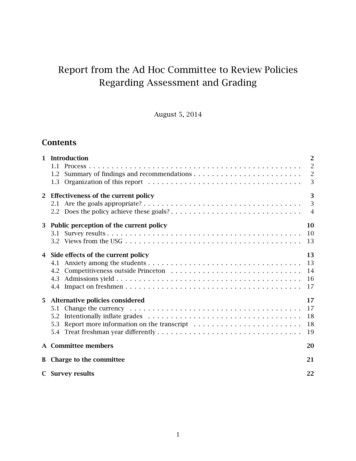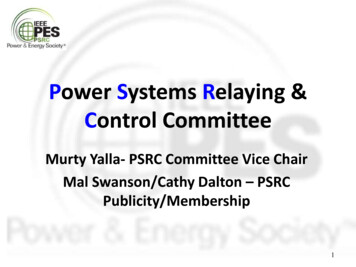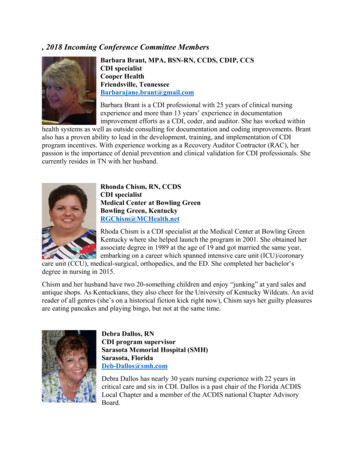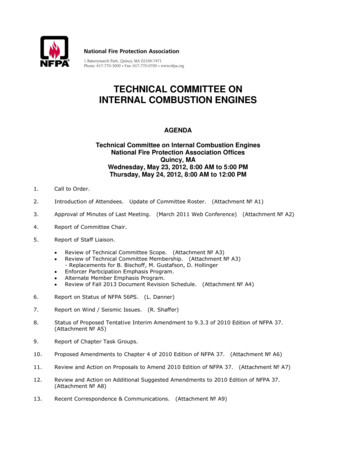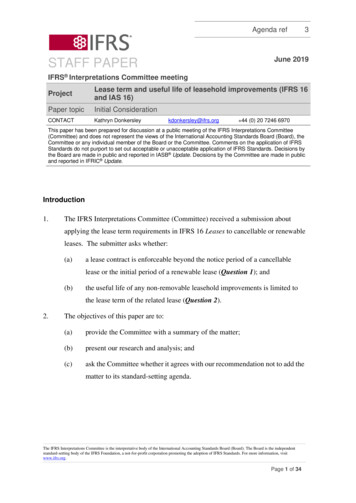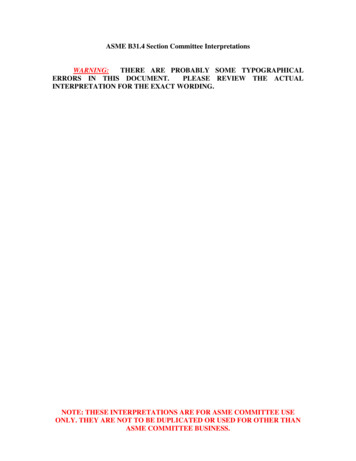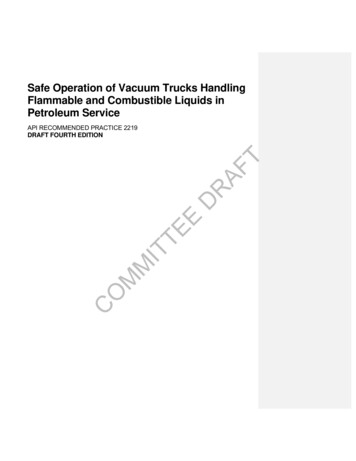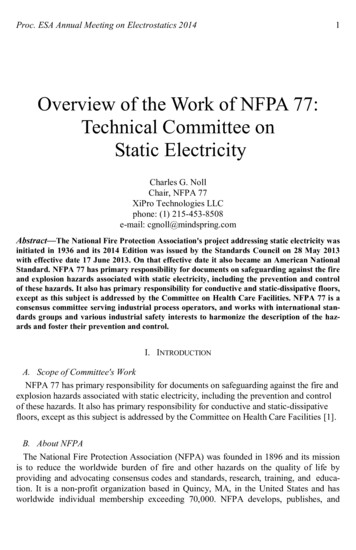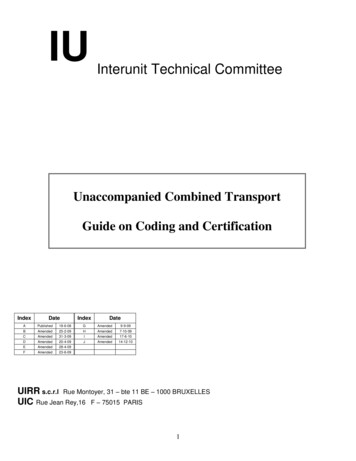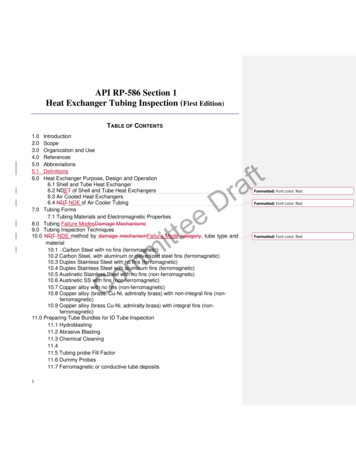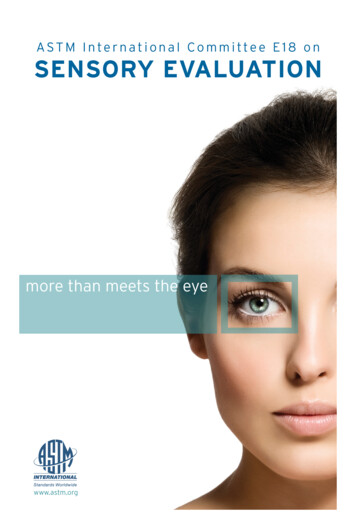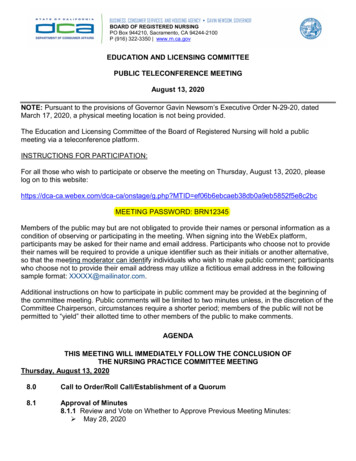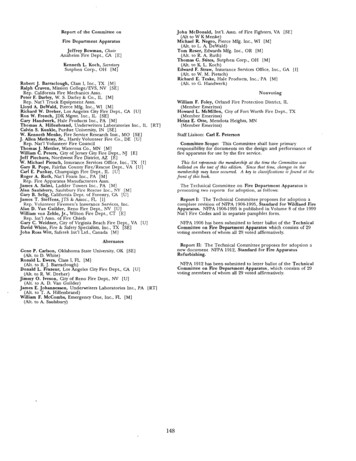
Transcription
Report of the Committee onJ o h n McDonald, Int'l. Assn. of Fire Fighters, VA [SE](Air to W K Menke)Michael R. Negro, Pierce Mfg. Inc., WI [M](Alt. to L. A. DeWald)Tom Reser, Edwards Mfg. Inc., OR [M](Alt. to R. A. Ruth)Thomas G. Stites, Sutphen Corp., OH [M](Alt. to K. L. Koch)Edward F. Straw, Insurance Services Office, Inc., GA [I](Alt. to W. M. Pietsch)Richard E. Teske, Hale Products, Inc., PA [M](Alt. to G. Handwerk)Fire Department ApparatusJeffrey Bowman, ChairAnaheim Fire Dept., CA [E]KEnneth L. Koch, SecretarySutphen Corp., OH [M]R o b e r t J . Barraclough, Class I, Inc., TX [M]Ralph Craven, Mission College/EVS, NV [SE]Rep. California Fire Mechanics Assn.Peter E Darley, W. S. Darley & Co., IL [M]Rep. Nat'l Truck Equipment Assn.Lloyd A. DeWald, Pierce Mfg. Inc., WI [M]Richard W. Dreher, Los Angeles City Fire Dept., CA [U]Ron W. French, JDK Mgmt. Inc., IL [SE]Gary Handwerk, Hale Products Inc., PA [M]Thomas A. Hillenbrand, Underwriters Laboratories Inc., IL [RT]Calvin S. Kunkle, Purdue University, IN [SE]W. Kenneth Menke, Fire Service Research Inst., MO [SE]J. Allen Metheny, St., Hartly Volunteer Fire Co., DE [U]Rep. Nat'l Volunteer Fire CouncilT h o m a s J . Mettler, Waterous Co., MN [M]William C. PetErs, City of Jersey City Fire Dept., NJ [E]Jeff Piechura, Northwest Fire District, AZ [ElW. Michael Pietseh, Insurance Services Office, Inc., TX [I]Gary R. Pope, Fairfax County Fire/Rescue Dept., VA [U]Carl E. Punkay, Champaign Fire Dept., IL [UIRoger A. Ruth, Nat'l Foam Inc., PA [M]Rep. Fire Apparatus Manufacturers Assn.James A. Salmi, Ladder Towers Inc., P A [ M ]Alan Saulsbury, Saulsbury Fire Rescue Inc., NY [M]Gary B. Selig, California Dept. of Forestry, CA [U]James T. Steffens, JTS & Assoc., FL [I]Rep. Volunteer Firemen's Insurance Services, Inc.Alan D. Van Guilder, R e n t Fire Dept., NV [U]William yon Zehle, Jr., Wilton Fire Dept., CT [ElRep. Int'l Assn. of Fire ChiefsGary C. Weidner, City of Virginia Beach Fire Dept., VA [U]David White, Fire & Safety Specialists, Inc., TX [SE]John Ross Witt, Safetek Int'l Ltd., Canada [M]NonvotingWilliam F. Foley, Orland Fire Protection District, IL(Member Emeritus)Howard L. MeMillen, City of Fort Worth Fire Dept., TX(Member Emeritus)Heinz E. Otte, Mendota Heights, MN(Member Emeritus)StaffLiaison: Carl E. PetersonCommittee Scope: T h i s Committee shall have primaryresponsibility for documents on the design and performance offire apparatus for use by the fire service.This list represents the membership at the time the Committee wasballoted on the text of this edition. Since that time, changes in themembership may have occurred. A key to classifications is fouled at thefront of this book.The Technical Committee on Fire Department Apparatus ispresenting two reports for adoption, as follows:Report h The Technical Committee proposes for adoption acomplete revision of NFPA 1906-1995, Standard for Wildland FireApparatus. NFPA 1906-1995 is published in Volume 8 of the 1999Nat'l Fire Codes and in separate pamphlet form.NFPA 1906 has been submitted to letter ballot of the TechnicalCommittee on l re Department Apparatus which consists of 29voting members of whom all 29 voted affirmatively.AlternatesReport Ih The Technical Committee proposes for adoption anew document NFPA 1912, Standard for Fire ApparatusRefurbishing.Gene P. Carlson, Oklahoma State University, OK [SE](Air. to D. White)Ronald L. Ewers, Class I, FL [M](Mt. to R.J. Barraclough)Donald L. Frazeur, Los Angeles City Fire Dept., CA [U](AIt. to R. W. Dreher)Jimmy O. Iveson, city of R e n t Fire Dept., NV [U](Alt. to A. D. Van Guilder)James E. Johannessen, Underwriters Laboratories Inc., PA [RT](Alt. to T. A. Hillenbrand)William F. McCombs, Emergency One, Inc., F-L [M](Alt. to A. Sanlsbury)NFPA 1912 has been submitted to letter ballot of the TechnicalCommittee on Fire Department Apparatus, which consists of 29voting members of whom all 29 voted affirmatively.148
NFPA 1906 NFPANovember19062000 ROPtolerance does not cause a functional problem for the Class A gOent . .MMITrEE ACTION: Accept in Prinople.Revise 14-8 (renumbered as ll-1O) to read as follows.Foam Proportioning System Accuracy. The foam proportioning:system shall be accurate throughout the manufacturer's statedrange of flow(s) and pressure(s). The accuracy of the foamproportioning system shall be tested by the apparatusmanufacturer prior to delivery of the app;u'atus. Systems designedto produce foam solution at ratios of less than 1 percent shallroportion foam concentrate to an accurao/of :1:20 pe,-cent.ystems designed to produce foam solution at ratios of 1 percentor greater shall proportion foam concenu'ate to an accuracy ofminus 0 plus 3 0 p e r c e n t or 1 percentage point, whichever is less.COMMITTEE STATEMENT: The committee feels the systemsneed to be tested at their rating points, not an arbitrarypercentage. The committee agrees with the submitter with regardto the accuracy of systems designed for less than 1 percent.Systems designed to proportion at 1 percent or greater aregenerally working with different concentrates where the percentageof concentrate in solution should not fall below th'e designedpercentage rate. The committee feels its wording of therequirement is meeting the intent of the submitter while not basingthe requirement on 2 particular points.-(Log #1)1906- 1 - (7-6.2): AcceptSUBMITTER: Lloyd A. DeWald, Fire Apparatus Manufacturers'Assn.RECOMMENDATION: Revise the second sentence in 7-6.2 toread a:s follows:"The stripe or combination of stripes shall be a minimum of 4 in.(100 ram) in total width and shall conform to the minimumrequirements of ASTM D 4956, Standard Specifications forRetroreflective Sheeting for Traffic Control, Type I, Class 1 or Class 3."SUBSTANTIATION: A proposal was submitted on February 23,1994 to change the language in NFPA 1901 regarding thespecification of reflective products. The old Federal SpecificationLS-300 referenced in the 1991 edition of NFPA 1901 was replacedwith ASTM 4956.The committee action on this proposal was to accept inprinciple. The committee a d d e d the title of the standard andchanged the reference to Type Ill as that is the cross-referenceestablished in the ASTM standard for Type I material in the I.S-300standard.While the committee action was correct in cross-referencing fromthe LS-300 standard to the new ASTM standard, there was not anunderstanding of the change in the minimum requirements' thatwas driven by the new ASTM standard. The reflectivityclassification from I. 300 (Reflectivity 2) did become ASTM D4956 (Type III); however, the reflective material used on police,EMS vehicles and fire apparatus is, in fact, Type I materialunderthe new ASTM standard.There are very few reflective products and fewer colors availablethat comply with the Type IIl dassification. Users do not like theappearance of Type III products due to the thickness of thematerial and the visible seams. Type III products are higherpriced and more difficult to apply which needlessly increases thecost of the fire apparatus. The Type III products have limitationsaffecting the graphic designs that can be applied on the fireapparatus. There is no evidence that Type Ill products erformbetter than Type I products on fire apparatus.PIt is believed that it was not the intent of the committee to raisethe standard for the reflective products being used on fireapparatus. The proposal was only to change from the old LS-300standard to the new ASTM standard. Accepting this TIA willcorrect the error that was made in translating from the oldstandard to the new and allows for the use o f the reflectivematerials that are currently being used on fire apparatus. This willreturn the standard to a minimum standard for reflectivity as it isintended to be.A TIA needs to be processed on this issue as the limitations ofthe Type Ill material make it unsatisfactory for most fire serviceapplications and the users are unwilling to accept this material.Continuing to build fire apparatus using the Type I material putsmanufacturers at a liability risk because the fire apparatus does notcomply with a nationally recognized standard. The TIA will bringthe NFPA 1901 standard into alignment with the practice 'in theindustry and reestablishes a minimum.performance standard. TheNFPA needs to implement a TIA to correct this immediately because the credibility of the NFPA standard is at risk when t h e standard is not followed.Note: Supporting material is available for review at NFPAHeadquarters.COMMITTEE ACTION: Accept.I COMMITTEE STATEMENT: This is now 6.6.2 in the reviseddocument.(Log #2)1906- 2 - (14-8): Accept in PrincipleSUBMITTEI John Gridley, Robwen, Inc.RECOMMENDATION: Revise text tO read as follows:The accuracy of the foam proportioning system shall be tested bythe apparatus manufacturer prior to delivery of the apparatus. Thefollowing parameters shall be met:0 - 1 percent - accuracy hall b e .or.- 20 percent"" "" " "3 percent - accuracy shall be 3 pi rcent to 4"percent6 percent - accuracy shall be 6 percent t o 7 p e r c e n tProportioners designed to operate between 0 - 1 percent shall betestect at 0.5 percent.SUBSTANTIATION: 43 percent to 40 percent will effectivelychange nominal setting by 20 percent. While negative factors arenot allowable for AFFF type foams because of the basic function ofthe agents, class A foams should not have these restrictions. A or149 (Log #CP1)1906- 3 - (Entire Document): AcceptSUBMITTER: Technical Committee on ] re Departmentl cal tUSOMMENDATION: The Technical Committee on FireDepartment Apparatusproposes a comph:te revision to the 1995edition of NFPA 1906, Standard for Wildland Fire Apparatus, asshown at the end of this report.SUBSTANTIATION: The Fire Department Apparatus Committeeappointed a task group to review the current edition of NFPA 1906,Standard for WildlandFire Apparatus, and makerecommendations to the full committee concerning thefunctionality of the current document. During that review, theTask Group suggested a general updating of the standard andfound that wildland fire apparatus typically does not have linevoltage electrical systems and recommended deleting that chapter. The Fire Department Apparatus Committee is recommending the "reorganization of the document into additional separate chaptersto correspond to the chapter organization, of NFPA 1901, Standardfor Automotive Fire Apparatus. Part of that reorganization is tomove the testing requirements which were: formerly all together ina single chapter into the chapter dealing ith the component orsystem that the tests pertain to. The chapter structure in the nextedition will be as follows:Chapter 1. AdministrationChapter 2. General RequirementsChapter 3. Chassis andVehicle ComponentsChapter 4. Low Voltage Electrical Systems and Warning Devices.Chapter 5. Driving and Crew AreasChapter 6. Body and CompartmentationChapter 7. PumpsChapter 8. Auxiliary Pump EnginesChapter 9. Water TanksChapter 10. Equipment Carried on Wildland Fire ApparatusChapter 11. Cla s A Foam Concentnate Proportioning SystemsChapter 12. Compressed Air Foam Systems (CAFS)Chapter 13. WinchesChapter 14. Vehicle Protection SystemsChapter 15. Referenced publicationsThe committee has updated the text and requirements, whereapplicabli , to those contained in NFPA 1901. The tables for ratingpumps have been increased to allow pum s up to 500 gpm (1893L/ram), as it was determined that some t:lre departments want theextra pumping capability available within their fire departmenteven though me apparatus is designed essentially for wildiand firefighting. These larger pumps will be required to meet the samerating points as fire pumps of 250 gpm (916 I /min) or greater inNFPA 1901 .COMMITrEE -ACTION: Accept.
NFPA 1906 NFPAStandardforNovember2000 ROPoptical device, between which the optical source contributesoptical power.1906Wildland Fire Apparatus1-7.4 Angle o f Approach. The smallest angle made between theroad surface and a line drawn from the front point of g r o u n dcontact of the front tire to any projection of the apparatus in frontof the front axle.2001 EditionNOTICE: An asterisk (*) following the n u m b e r or letterdesignating a paragraph indicates that explanatory material on theparagraph can be f o u n d in Appendix A.1-7.5 Angle o f Departure. The smallest angle made between theroad surface and a line drawn from the rear point of groundcontact of the rear tire to any projection of the apparatus behindthe rear axle.Information on referenced publications can be f o u n d in Chapter15 a n d A p p e n d i x C.1-7.6" Approved. Acceptable to the authority having jurisdiction.Chapter1 Administration1-7.7 ASME Pressure Vessel. A pressure vessel used for the storageor accumulation of air or gas u n d e r pressure that is constructeda n d tested in accordance with the ASME Boiler and Pressure VesselCodeI-I* Scope. This standard shall apply to new automotive fireapparatus designed primarily for wildland fire suppression whetherconfigured as an integral part of the chassis or a self-contained slipon unit. The apparatus shall be capable of supporting p u m p androll operations, ff the primary purpose of the apparatus is tosupport structural fire fighting or associated fire d e p a r t m e n toperations, the requirements of NFPA 1901, Standard for AutomotiveFire Apparatus shall apply.1-7.8" Authority Having Jurisdiction. The organization, office, orindividual responsible for approving equipment, an installation, ora procedure.1-7.9" Automatic !ectrical Load Management System. A devicethat continuously.: n.itors the electrical system voltage and shedsp r e d e t e r m i n e d J i ": -:a selected order to prevent overdischargingof the a p p a a t t e r i e s .1-2 Purpose. This standard specifies the m i n i m u m requirementsfor a new automotive wildland fire apparatus to include selfcontained slip-on units.1-7.10" A mat ii .- walating Proportioning System. Apropor.ti rai .syste iii 't at aljt'omat cally adjtists the flow of foamconc., : ':i :i o the : e a mto maintain the desiredpr: : rti .!ng ratio.:; i'-"1-3 Equivalency. Nothing in this standard is i n t e n d e d to preventthe use of systems, methods, or devices of equivalent or superiorquality, strength, fire resistance, effectiveness, durability, and safetyover those prescribed by this standard. Technical d o c u m e n t a t i o n":{ ' :!iI . }.:: ' .ry Engine-Driven Pumps. Pumps whose power isshall be submitted to the authority having jurisdiction toprovflzl' i'by e'figines that are i n d e p e n d e n t of the vehicle engine.demonstrate equivalency. The system, m e t h o d , or device shall be:!::ii. 1-7.12 t : ' A l a r m .An audible device designed to warn thatapproved for the i n t e n d e d purpose by the authority having':i::i:::i:i!i!i::i::iii!:!tlaevehicle iitn reverse gear.jurisdiction. :.::. "":'::::::i:':i:i::.'::.-.-. .- :"14 Application. This standard is applicable to new fire apparatus " i { i i ! . . ' i i i i b b l e (Foam). A thin-walled, roughly spherical, film ofcontracted for on or afterJanuary 1 2001 however nothing.:: l:i::".!-::-- quid.:it: atedwith air.prevent the use of the standard prior to January 1, 2001 i : :::i { ii:: -ii:.: :. , , ," . . . . . . . . . . . . .purchaser and contractor agree. The standard is n o t i 4 h d e d b e:i{!'.i .t:.::.?#"') e721 gnfi72nT s reeg27;t?tra2e ne e te snog?:aTl ;nttlatapplied retroactively .i';'iiii.::.'. . . . ii.:.' i:.-.:!::::.":ii::,.i::ii.- mP , P. . . .":" "::!: ?i::.::!::::""'.:::i::::::::.,.':."-."m o n o x t o e ttou).1-5" Responsibility o f Purchaser. It shall be the r e s p o n ' . t y of ""-:::::":.:# : . . . . . . . . . . . . . . .w . . . . the ent; e woi-ht ofoth:purcLa ; r it2c uP Cin oth:2e o e f L t h a e a p 2 a O O . - : : : : : " h'e r e e : : 2 g s T V o l i 2 e r e e o t ) c o 7 C t r a t e d so'tha . 'fp,g pp 4::oR.e ::. :::::".' elevations above 2000 ft (610 L 3 or on h i " rade ter s u p p o r t e d at this point, m e apparatus would r e m a i n m e q m h b n u m -.-.-:.-toin any position.20 p e r c e n t are reqmred;the maxamum. .i r s :. Y ;of f i r eN.:.:t .htersridem"t h m cal " the apparatus. ;. specific" a d d. e d co" .ous. . . e l e i!'"1-7.16 Chassis. The basic operating motor vehicle including theloads that exceed the r m m m u m of this s.tanda? ii .d a .#:hose,engine, frame, a n d other essential structural and mechanical parts,g r o u n d ladders,, or e q u i p m e n t to b e c arn.ed by t f f . . a r a t u s that.but exclusive of the body and all appurtenances for theexceect m e m i n i m u m r e q m r e m e n t s ot tins stmmar 5::a c c o m m o d a t i o n of driver, property, passengers, appliances, ore q u i p m e n t related to other than control. C o m m o n usage might,1-6 Responsibility o f C o n t r a c t o r .but n e e d not, include a cab (or cowl).1-6.1 The contractor shall provide a detailed description of the1-7.17 Class A Fire. A fire in ordinary combustible materials, suchapparatus, a list of e q u i p m e n t to be furnished, and otheras wood, cloth, paper, rubber, and many plastics.construction and performance details to which the apparatus shallconform. This shall include, but shall n o t be limited to, estimated1-7.18 Class A Foam. Foam intended for use on Class A fires weight, wheel base, principal dimensions, transmission, and axleratios, if applicable. T h e purpose of these contractor specifications1-7.19" C o m p o u n d Gage. A gage that indicates pressure bothshall be to define what the contractor intends to furnish and deliverabove a n d below atmospheric pressure.to tile purchaser.1-7.20" Compressed Air Foam System (CAFS). A foam system that1-6.2 Responsibility for the apparatus and e q u i p m e n t shall remaincombines air u n d e r pressure with foam solution to create foam.with the contractor until they are accepted by the purchaser.1-7.21 Continuous Duty. Operation at a constant rated load for an1-6.3 A qualified and responsible representative of the contractorindefinitely long period.shall instruct personnel specified by the purchaser in the1-7.22" Contractor. The person or company responsible foroperation, care, and maintenance of the fire apparatus a n dfulfilling an agreed u p o n contract.equipment delivered 1-71-7.23 Convenient Reach. The ability of the operator tomanipulate the controls from a driving/riding position withoutexcessive m o v e m e n t away from the seat back or without excessiveloss of eye contact with the roadway Definitions.1-7.1 Acceptance. An a g r e e m e n t between the purchasing authorityand the contractor that the terms and conditions of the contracthave b e e n met.1-7.24 Defect. A discontinuity in a part or a failure to functionthat interferes with the service or reliability for which the part wasintended 1-7.2 Acceptance Tests. Tests p e r f o r m e d on behalf of or by thepurchaser at the time of delivery to d e t e r m i n e compliance with thespecifications for the fire apparatus.1-7.25 Discharge Outlet Size. The nominal size of the first firehose connection from the pump.1-7.3 Active Horizontal Angles o f Light Emission. The angles,measured in a horizontal plane passing t h r o u g h the optical centero f the optical source, as specified by the manufacturer of the150
NFPA 1906 -- November1-7.49 Intake Connection Size. The nominal size of the first firehose connection'from the pump.1-7.26 DOT Cylinder. Apressure vessel constructed a n d tested inaccordance with 49 CFR 178.37, that is used for the storage and .transportation of air under pressure.1-7.50 Interlock. A device or arrangement by means of which thefunctioning of one part is contJ'olledby the functioning of another.1-7.27" Eductor. A device placed in a hose line or a discharge pipethat incorporates a venturi and proportions foam concentrate intothe water stream.1-7.51 Label. A visual
Heinz E. Otte, Mendota Heights, MN (Member Emeritus) StaffLiaison: Carl E. Peterson Committee Scope: This Committee shall have primary responsibility for documents on the design and performance of fire apparatu
